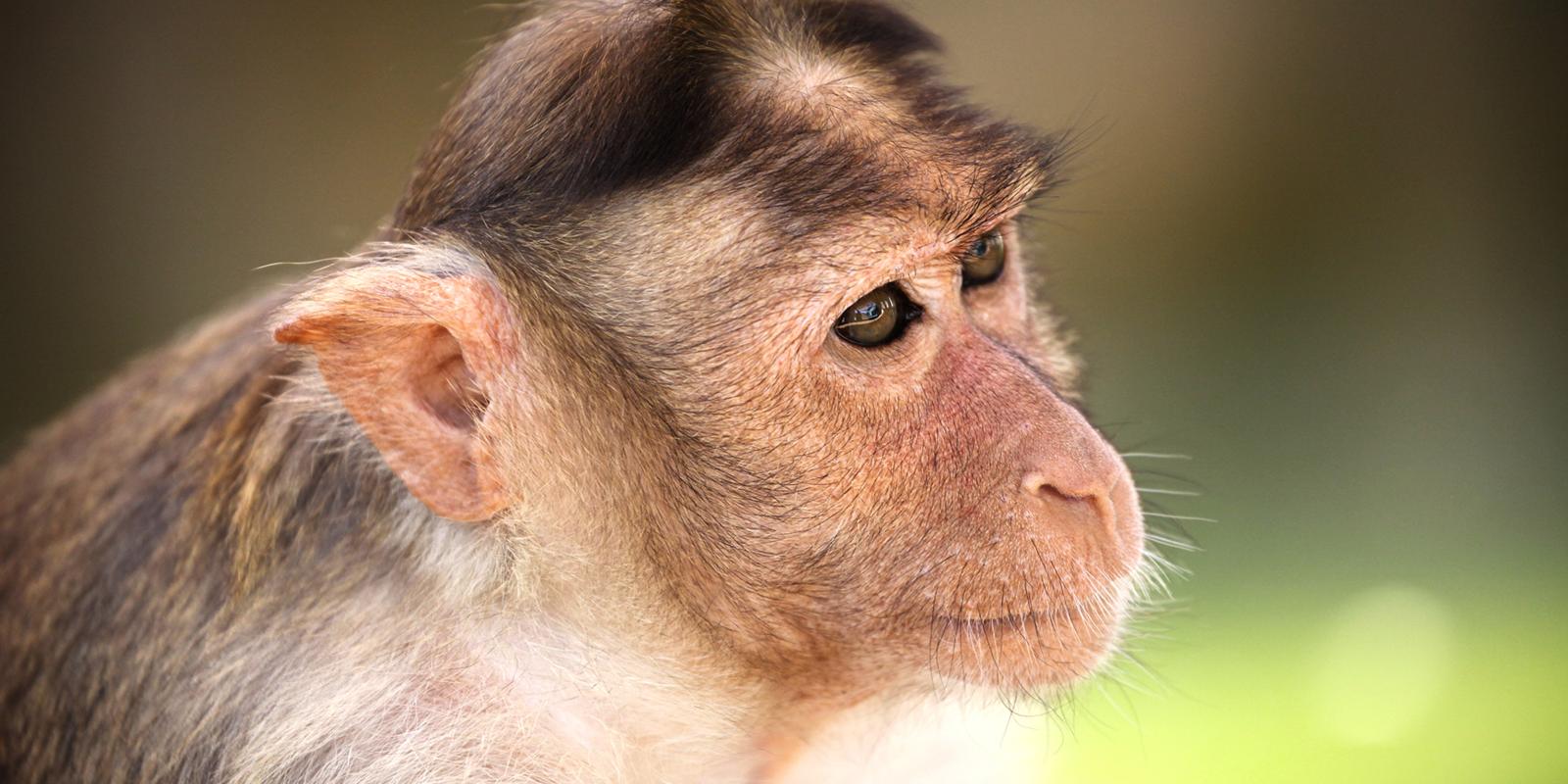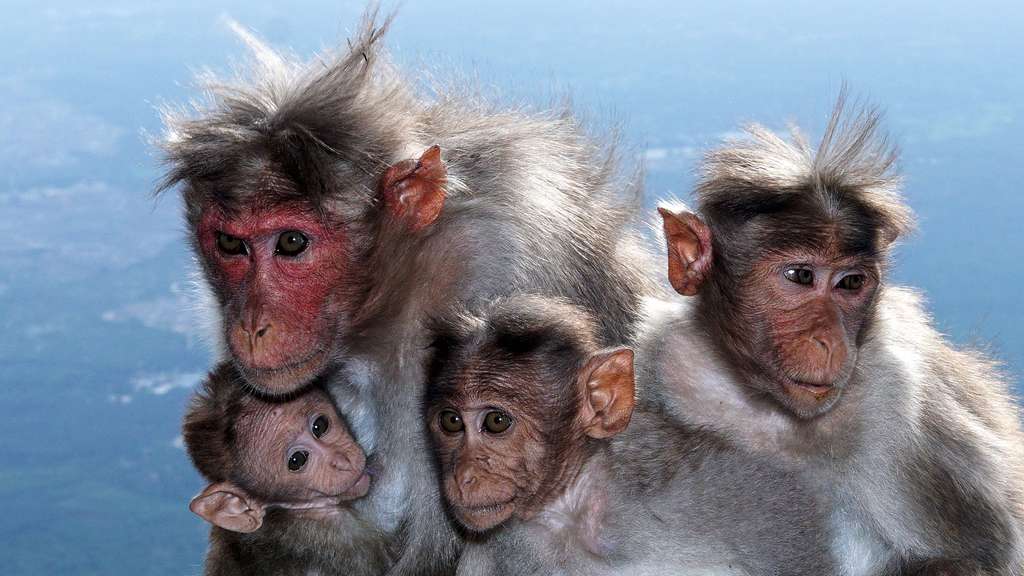
Macaque Portrait Fulllength Stock Image Image of nature, primate 22674733
Habitat. Bonnet Macaque troops have a home range with a core area of around 120 acres (50 hectares). They are comfortable in trees and on the ground, and as well as living in many different forest types, they will use plantations and agricultural areas. Many populations live near human settlements and now rely on food raided from houses.

What The Fauna? • This baby macaque (looks like a macaque of... Cute baby animals, Baby
Here we investigated sociodemographic and anthropogenic determinants of infant survival (up to 1 yr of age) in free-ranging bonnet macaques (Macaca radiata) living in a periurban environment in Southern India. We conducted the study from November 2016 to May 2018, on two groups of bonnet macaques at the Thenmala tourist site in the state of Kerala.

Macaque …One of the 4 Macaques endemic to Southern India Wild Nest
Comprising two subspecies, the more common dark-bellied bonnet macaque, macaca radiata radiata, is found in the peninsula's evergreen and deciduous forests, on dry prairies, and in urban… LEARN MORE ABOUT BONNET MACAQUES Photo courtesy of ©Erin Riley. Used with permission. BOOTED MACAQUE Macaca ochreata CONSERVATION STATUS: VULNERABLE

Macaque Macaca Radiata Baby Monkey In Captivity Laos Southeast Asia HighRes Stock Photo
This Bonnet macaque, an Old World monkey is a giant animal. It is 35-60 cm long and has a tail of 35-68 cm. Males weigh 5.5 to 9.0 kg, females 3.5 to 4.5 kg. Captive monkeys can live up to 35 years. Bonnet macaque feeds on fruits, nuts, seeds, flowers, varieties, and cereals. In southern India, this macaque is useful as a human, feeding human.

Macaque Mischieviously Watching. Stock Photo Image of jungle 64500968
The Bonnet Macaque [1], also called Zati, is a species of macaque native to southern India. Bonnet macaques get their common name from a unique feature: a hood-like tuft of hair that extends from the top of their head, much like a tuft of dry grass. Framed by large ears, a bonnet macaque's wrinkled, hairless face commands attention.

Mano Wildlife Photography
Bonnet macaques are found in a variety of habitats, including evergreen high forest and dry deciduous forest of the Western Ghat Mountains. They are highly arboreal and are strong swimmers. They often wander onto dry prairies, although it is not their preferred habitat.

Macaque Krishna Mohan Photography
Le Macaque à bonnet ( Macaca radiata) est une espèce de singes de la famille des Cercopithecidae qui vit en Inde . Dénominations L'espèce est également appelée Macaque bonnet chinois 1, 2 ou simplement Bonnet chinois 1 en raison de la forme de sa tête qui évoque le couvre-chef asiatique 3. On rencontre aussi parfois le nom Macaque commun 1 .

macaque yawning Stock Image C029/3704 Science Photo Library
The bonnet macaque , also known as zati, is a species of macaque endemic to southern India. Its distribution is limited by the Indian Ocean on three sides and the Godavari and Tapti Rivers, along with its related competitor the rhesus macaque in the north. Land use changes in the last few decades have resulted in changes in its distribution boundaries with the rhesus macaque, raising concern.

Monkeys seen in Mahabaleshwar Macaque Punemate
bonnet monkey, ( Macaca radiata ), macaque of southern India named for the thatch of long hair forming a cap, or "bonnet," on the head. The bonnet monkey is grayish brown with a hairless pink face. It is about 35-60 cm (14-24 inches) long, excluding its long tail. Average adult females weigh about 4 kg (9 pounds), adult males 6.7 kg.

Karnataka, montagnes de Sanduru, Macaque à , mâle adulte. News Photo Getty Images
The Bonnet Macaque (Macaca radiata) is a macaque that resides in India. The Bonnet Macaque is a diurnal monkey which means it is mostly active during the daytime. Bonnet Macaques are around 35 - 60 centimetres long plus a tail of 35 - 68 centimetres. Male Bonnet Macaques weigh 5.5 to 9 kilograms and females 3.5 to 4.5 kilograms.

Macaque Macaque, Primates,
Their diet is comprised of fruits, cereals, leaves, roots, buds, stems, birds' eggs, and invertebrates (crickets, spiders, termites, caterpillars). Indian Bonnet Macaque: Overview According to.

Macaque Macaque, Primates,
Bonnet macaques are protective parents, and the whole group helps watch out for the safety of the babies. If an infant is separated from the group, young males and one or more females will go out.

Macaque Al Ain Zoo
Lion-tailed and bonnet macaques need different conservation plans, says expert. by Bhanu Sridharan on 6 February 2020. A primatologist reviews 40 years of research on two species of monkeys in South India and offers some lessons for conservation. A recent paper highlights the issues faced by the Lion-tailed macaque, a forest-dwelling monkey.

Photo Le macaque à
The Assam macaque, also known as Assamese macaque, is a macaque of the Old-World monkey family endemic to South and Southeast Asia. Assam is another state in India. Eating everything from fruits to 55 types of flowers, leaves, seeds, and bark, these macaque monkeys adapt their diet to suit their habitat. Read more Barbary Macaque

macaque Macaque monkey, Macaque, Monkey drawing
A bonnet macaque is smaller than many other macaque cousins, weighing, on average, about 8.5lbs (3.9kg) for females and 14lbs (6.7kg) for males, with average lengths of 14in (35cm) to 24in (60cm), for females and males respectively. The tail measures two-thirds the length of the body.

Portrait of a Macaque The Macaque (macaca radiata) … Flickr
The bonnet macaque ( Macaca radiata ), also known as zati, is a species of macaque endemic to southern India. Its distribution is limited by the Indian Ocean on three sides and the Godavari and Tapti Rivers, along with its related competitor the rhesus macaque in the north.